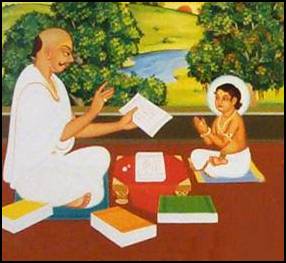Swaminarayan
Swaminarayan (3 April 1781 – 1 June 1830), also known as Sahajanand Swami, was a yogi, and an ascetic whose life and teachings brought a revival of central Hindu practices of dharma, ahimsa (non-violence), brahmacharya (celibacy), and Aparigraha (non-possessiveness). He is believed by followers as a manifestation of God. Swaminarayan was born Ghanshyam Pande in Chhapaiya, Uttar Pradesh, India. He began a seven-year pilgrimage across India as a teenager, adopting the name Nilkanth Varni. Swaminarayan then settled in the state of Gujarat and established a new religious movement characterized by a strict ethic of diet, personal behavior, and social reform.
Early Life[edit | edit source]
Swaminarayan was born in a Hindu Brahmin family in 1781. His early years were marked by a series of spiritual quests, which led him to leave home at the age of 11 to embark on a seven-year pilgrimage across the Indian subcontinent. During his travels, he met various sages and ascetics and engaged in deep meditation and spiritual practices.
Teachings and Philosophy[edit | edit source]
Swaminarayan's teachings focused on the importance of morality, purity, and devotion to God. He preached against the caste system and advocated for social justice and equality, promoting a community that upheld the values of honesty, non-violence, and vegetarianism. Swaminarayan emphasized the worship of Krishna and considered himself a servant of Krishna. His philosophical foundation was based on the dualism of Jiva (soul) and Brahman (ultimate reality), and he encouraged his followers to live a disciplined life of devotion.
Swaminarayan Sampraday[edit | edit source]
Swaminarayan established the Swaminarayan Sampraday, also known as the Bochasanwasi Shri Akshar Purushottam Swaminarayan Sanstha (BAPS), with its own code of conduct and administrative structure. He built six temples in his lifetime and appointed his closest disciples to spread his teachings. The sect has grown significantly since his death, with temples and followers around the world.
Legacy[edit | edit source]
Swaminarayan's legacy includes a vast body of scriptures, including the Vachanamrut, a collection of his sermons, and the Shikshapatri, a book of precepts. His teachings continue to influence millions of followers globally, and the Swaminarayan movement is recognized for its contributions to social welfare, education, and spiritual upliftment.
Controversies[edit | edit source]
Swaminarayan's life and the movement he founded have not been without controversy. Critics have debated his claim to divinity and the strict social codes he promoted. However, his followers maintain that his teachings and works exemplify the highest ideals of Hinduism.
Temples and Festivals[edit | edit source]
The Swaminarayan movement is known for its grand temples and vibrant festivals. The Akshardham temple in Delhi and the Swaminarayan Temple in Ahmedabad are notable examples of the architectural and cultural contributions of the movement. Festivals like Janmashtami and Diwali are celebrated with great fervor, emphasizing the importance of community and devotion in the Swaminarayan tradition.
Navigation: Wellness - Encyclopedia - Health topics - Disease Index - Drugs - World Directory - Gray's Anatomy - Keto diet - Recipes
Search WikiMD
Ad.Tired of being Overweight? Try W8MD's physician weight loss program.
Semaglutide (Ozempic / Wegovy and Tirzepatide (Mounjaro) available.
Advertise on WikiMD
WikiMD is not a substitute for professional medical advice. See full disclaimer.
Credits:Most images are courtesy of Wikimedia commons, and templates Wikipedia, licensed under CC BY SA or similar.
Contributors: Prab R. Tumpati, MD






